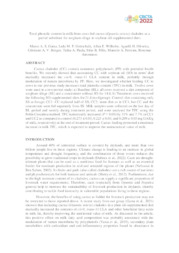Total phenolic content in milk from cows fed cactus (Opuntia stricta) cladodes as a partial substitute for sorghum silage in soybean oil-supplemented diets.
Total phenolic content in milk from cows fed cactus (Opuntia stricta) cladodes as a partial substitute for sorghum silage in soybean oil-supplemented diets.
Autoria: GAMA, M. A. S. da; GOTTSCHALK, L. M. F.; WILHELM, A. E.; OLIVEIRA, A. H.; BORGES, C. A. V.; PAULA, T. A.; FÉLIX, S. B.; FERREIRA, M. A.; ANTONIASSI, R.
Resumo: Cactus cladodes (CC) contain numerous polyphenols (PP) with potential health benefits. We recently showed that associating CC with soybean oil (SO) in cows' diet markedly increased the cis-9, trans-11 CLA content in milk, probably through modulation of rumen microbiota by PP. Here, we investigated whether feeding CC to cows in our previous study increases total phenolic content (TFC) in milk. Twelve cows were used in a two-period study: a) Baseline (BL): all cows received a diet composed of sorghum silage (SS) and a concentrate without SO for 14 d; b) Treatment: cows received the following SO-supplemented diets for 21 d (n=4/group): Control: diet containing only SS as forage; CC1: CC replaced half of SS; CC2: same diet as in CC1, but CC and the concentrate were fed separately from SS. Milk samples were collected on the last day of BL period and weekly during treatment period, and were analysed for TFC using the Folin-Ciocalteu method. TFC numerically increased (P > 0.05) by 31% and 7.7% in CC1 and CC2 as compared to control (0.273 ± 0.03, 0.225 ± 0.03, and 0.209 ± 0.03 mg GAE/g of milk, respectively) at the end of treatment period. Cactus feeding promoted a moderate increase in milk TFC, which is expected to improve the nutraceutical value of milk.
Ano de publicação: 2022
Tipo de publicação: Artigo em anais e proceedings
Unidade: Embrapa Pecuária Sudeste
Palavras-chave: Cactus cladodes, Cis 9, Forage, Nutraceutical value of milk, Polyphenols, Rumen microbiota, Total phenolic content, Trans 11 CLA
Observações
1 - Por padrão são exibidas publicações dos últimos 20 anos. Para encontrar publicações mais antigas, configure o filtro ano de publicação, colocando o ano a partir do qual você deseja encontrar publicações. O filtro está na coluna da esquerda na busca acima.
2 - Para ler algumas publicações da Embrapa (apenas as que estão em formato ePub), é necessário ter, no celular ou computador, um desses softwares gratuitos. Sistemas Android: Google Play Livros; IOS: iBooks; Windows e Linux: software Calibre.
Acesse outras publicações
Acesse a Base de Dados da Pesquisa Agropecuária (BDPA) para consultar o acervo completo das bibliotecas da Embrapa.

